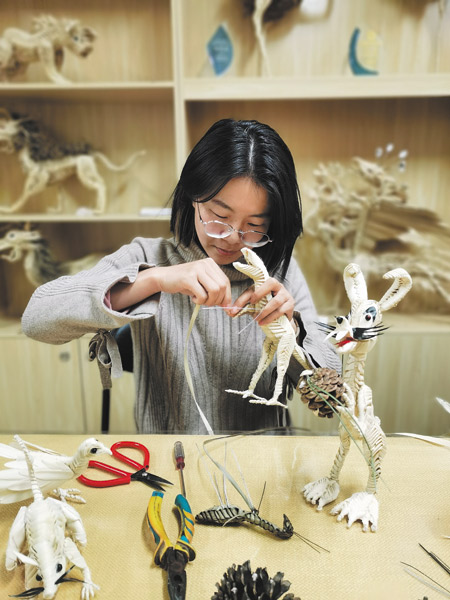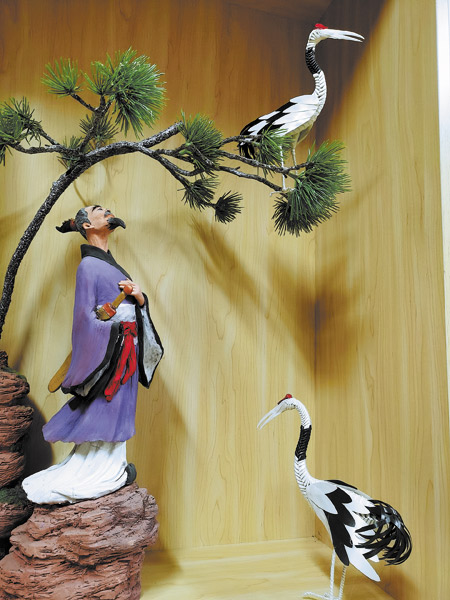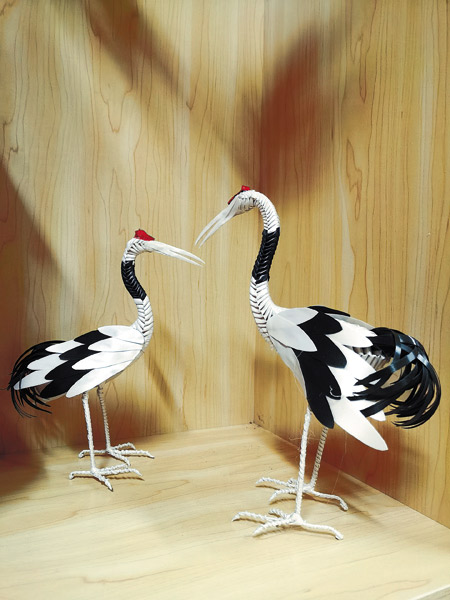Weaving a Brighter Future for Traditional Craft

Wu Cui makes a straw-woven dinosaur at a studio in Beijing in October.
Young straw-plaiting craftswoman aspires to bring new splendor to ancient technique
What's the first thing that pops into your mind when you think of wheat straw? Most people would probably just see it as a pile of waste in a farmer's field. However, Wu Cui, an intangible cultural inheritor, can turn the straw left over from harvested wheat into beautiful and eye-catching functional artworks.
"The most common materials, such as wheat stalks, corn husks and reeds, once processed by the hands of craftsmen, can be magically transformed," says Wu, a straw plaiting craftswoman from Helan county, Northwest China's Ningxia Hui autonomous region.
Straw plaiting is a method of manufacturing daily items or artworks by braiding straw. It was listed as a national intangible cultural heritage in 2008.
"The technique enjoys a profound history in China and has played a significant role in the daily lives of common people, whether it's wearing slippers or hats made from straw, or using a straw basket or a straw mat," explains Wu, 28, a sixth-generation inheritor of straw plaiting.
The earliest straw-woven products were unearthed at Hemudu Cultural Ruins, a Neolithic cultural site located in East China's Zhejiang province. The Book of Rites, one of the classical works of Confucianism, also records that there were already mats made of cattail grass and professional straw-weaving craftsmen during the Zhou Dynasty (c.11th century-256 BC).
For Wu, her family have provided a lot of support, while the countryside, where she got involved with the craft, is a source of inspiration.
"Immersed in an atmosphere with a passion for the technique, I made the straw-plaiting my job and started from scratch after graduating from university two years ago," Wu says.
Now, she is working at a company in Beijing that focuses on the promotion of traditional crafts, such as straw plaiting and clay sculpture.
Wu also described her uncle, the fifth-generation inheritor of straw plaiting, as her first teacher.
"As a child I had a penchant for catching grasshoppers and remembered how my uncle taught me to make a grasshopper cage, my first straw-weaving work," she recalls.

Straw-braided cranes are arranged to form an artistic scene.
To complete a work, Wu says she is meticulous about planning, production and revision, a practice the young woman adheres to with every piece.
Different pieces need different materials, Wu says, adding that products modeled after insects are usually made using leaves from palm trees or reeds, while hats, small baskets, and big animals are mostly made using straw.
Wu explains the process of straw weaving: "When the wheat is ripe, pick the top part of the straw, the one with the ears of wheat, as it is longer. Then tie them up and dry them. Before knitting, the wheat straws need to be soaked in warm water to make them more flexible and avoid them breaking."
A layman might think that the work is just about the actual weaving. According to Wu, however, selection of materials is the first step of a complicated, time-consuming and labor-intensive process that can take weeks, or even months, to complete.
"You need to sketch the piece on paper, which requires drawing skills, and also conceive its three-dimensional structure. Next comes the weaving, shaping and finally the preserving of the work," Wu adds.
"Even by adhering to that process, it does not mean that you will always create a good piece of work, and the hardest part is to make it lifelike and solid," Wu says, adding that, to this end, she will take pieces apart and try again.
Wu recalls that, when she was a child, woven straw items could be found almost in every household in the countryside, such as straw hats and straw shoes, because they were practical in everyday life.
"Due to the impact of industrialization, manufactured goods have replaced such products, which yield low profits, and there are only about 100 individuals engaging in the work across the country," she notes.
"The world has changed, and craftsmen need to transcend practicality and pursue the beauty and artistry of straw culture to help the craft survive and thrive," she says.

The two straw cranes made by Wu.
From her perspective, straw plaiting should respond to people's needs and preferences, while still drawing inspiration from traditional culture.
In today's fast-paced modern life, people have a desire to embrace nature and find pleasure in it, she says, adding that straw plaiting can meet people's spiritual and cultural needs.
"For instance, intangible cultural heritage has growing importance on campus, and I used to be invited to teach students about the history of, and demonstrate, the straw plaiting technique," she says, adding that students were very engaged and eager to learn about it.
"We also exhibit works that are popular in the market at our office, which always draws people's attention," she says.
"By occupying a position in the market and winning the hearts of consumers, more people will understand the culture behind the techniques, and more craftspeople will be encouraged to devote themselves to it as a career," she adds.
"Thanks to government's emphasis on precious folk crafts, straw plaiting will have a larger public profile," she says.
At present, China has established a tiered system of intangible cultural heritage, spanning the national, provincial, municipal and county levels, and it has identified more than 100,000 representative items of each one.
"For straw plaiting to blossom, craftspeople should make a concerted effort to grasp the trends and opportunities of the times to create new and relevant products," she says.
When asked about her plans, Wu says she aspires to dig deeper into local traditional culture and create cultural creative products by fully leveraging the straw plaiting technique.
"I will try to make products modeled on the rock paintings of Helan Mountain, which have a profound history, and take measures to bring new splendor to the ancient traditional craft," she says.